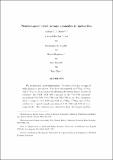Files in this item
Neutron-poor nickel isotope anomalies in meteorites
Item metadata
| dc.contributor.author | Steele, Robert C. J. | |
| dc.contributor.author | Coath, Christopher D. | |
| dc.contributor.author | Regelous, Marcel | |
| dc.contributor.author | Russell, Sara | |
| dc.contributor.author | Elliott, Tim | |
| dc.date.accessioned | 2018-09-06T08:30:05Z | |
| dc.date.available | 2018-09-06T08:30:05Z | |
| dc.date.issued | 2012-09-26 | |
| dc.identifier | 255735788 | |
| dc.identifier | ebf39722-502d-4dcd-8155-90eded4eaddd | |
| dc.identifier | 84866952051 | |
| dc.identifier.citation | Steele , R C J , Coath , C D , Regelous , M , Russell , S & Elliott , T 2012 , ' Neutron-poor nickel isotope anomalies in meteorites ' , Astrophysical Journal , vol. 758 , no. 1 , 59 . https://doi.org/10.1088/0004-637X/758/1/59 | en |
| dc.identifier.issn | 0004-637X | |
| dc.identifier.other | ORCID: /0000-0003-1406-6855/work/64034757 | |
| dc.identifier.uri | https://hdl.handle.net/10023/15975 | |
| dc.description.abstract | We present new, mass-independent, Ni isotope data for a range of bulk chondritic meteorites. The data are reported as ε60Ni58/61 , ε62Ni58/61 , and ε64Ni58/61 , or the parts per ten thousand deviations from a terrestrial reference, the NIST SRM 986 standard, of the 58Ni/61Ni internally normalized 60Ni/61Ni, 62Ni/61Ni, and 64Ni/61Ni ratios. The chondrites show a range of 0.15, 0.29, and 0.84 in ε60Ni58/61 , ε62Ni58/61, and ε64Ni58/61 relative to a typical sample precision of 0.03, 0.05, and 0.08 (2 s.e.), respectively. The carbonaceous chondrites show the largest positive anomalies, enstatite chondrites have approximately terrestrial ratios, though only EH match Earth's composition within uncertainty, and ordinary chondrites show negative anomalies. The meteorite data show a strong positive correlation between ε62Ni58/61 and ε64Ni58/61, an extrapolation of which is within the error of the average of previous measurements of calcium-, aluminium-rich inclusions. Moreover, the slope of this bulk meteorite array is 3.003 ± 0.166 which is within the error of that expected for an anomaly solely on 58Ni. We also determined to high precision (~10 ppm per AMU) the mass-dependent fractionation of two meteorite samples which span the range of ε62Ni58/61 and ε64Ni58/61. These analyses show that "absolute" ratios of 58Ni/61Ni vary between these two samples whereas those of 62Ni/61Ni and 64Ni/61Ni do not. Thus, Ni isotopic differences seem most likely explained by variability in the neutron-poor 58Ni, and not correlated anomalies in the neutron-rich isotopes, 62Ni and 64Ni. This contrasts with previous inferences from mass-independent measurements of Ni and other transition elements which invoked variable contributions of a neutron-rich component. We have examined different nucleosynthetic environments to determine the possible source of the anomalous material responsible for the isotopic variations observed in Ni and other transition elements within bulk samples. We find that the Ni isotopic variability of the solar system cannot be explained by mixing with a component of bulk stellar ejecta from either SN II, Wolf-Rayet or, an asymptotic giant branch source and is unlikely to result from bulk mixing of material from an SN Ia. However, variable admixture of material from the Si/S zone of an SN II can create all the characteristics of Ni isotope variations in solar system materials. Moreover, these characteristics can also be provided by an SN II with a range of masses from 15 to 40 M☉ , showing that input from SN II is a robust source for Ni isotope variations in the solar system. Correlations of Ni isotope anomalies with O, Cr, and Ti isotope ratios and Pb/Yb in bulk meteorites suggest that the heterogeneous distribution of isotopic anomalies in the early solar system likely resulted from nebular sorting of chemically or physically different materials bearing different amounts of isotopes synthesized proximally to the collapse of the protosolar nebula. | |
| dc.format.extent | 648727 | |
| dc.language.iso | eng | |
| dc.relation.ispartof | Astrophysical Journal | en |
| dc.subject | Astrochemistry | en |
| dc.subject | Meteorites, meteors, meteoroids | en |
| dc.subject | Methods: analytical | en |
| dc.subject | Nuclear reactions | en |
| dc.subject | Nucleosynthesis | en |
| dc.subject | Abundances | en |
| dc.subject | Protoplanetary disks | en |
| dc.subject | QB Astronomy | en |
| dc.subject | GE Environmental Sciences | en |
| dc.subject.lcc | QB | en |
| dc.subject.lcc | GE | en |
| dc.title | Neutron-poor nickel isotope anomalies in meteorites | en |
| dc.type | Journal article | en |
| dc.contributor.institution | University of St Andrews. School of Earth & Environmental Sciences | en |
| dc.identifier.doi | https://doi.org/10.1088/0004-637X/758/1/59 | |
| dc.description.status | Peer reviewed | en |
This item appears in the following Collection(s)
Items in the St Andrews Research Repository are protected by copyright, with all rights reserved, unless otherwise indicated.

